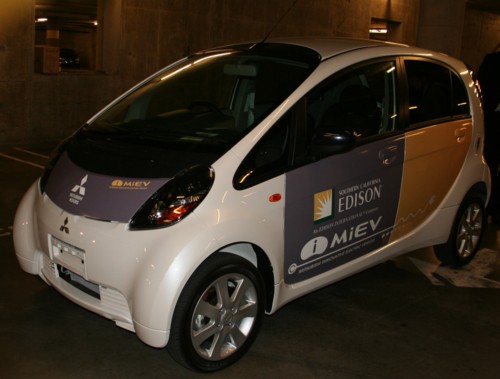







Mitsubishi i-MiEV test drive
Mitsubishi i-MiEV test drive
By Noel Adams
 On
November 20 at the Los Angeles Auto Show I got to test drive one of the i-MiEV
electric cars that are currently undergoing fleet tests with southern California
Edison. The test was conducted by David Patterson, Senior Manager,
Mobile Emissions Regulatory Affairs and Certification who is the person
responsible for fleet tests here in the USA.
On
November 20 at the Los Angeles Auto Show I got to test drive one of the i-MiEV
electric cars that are currently undergoing fleet tests with southern California
Edison. The test was conducted by David Patterson, Senior Manager,
Mobile Emissions Regulatory Affairs and Certification who is the person
responsible for fleet tests here in the USA.
The First thing we did was to take a look at the charging ports. Yes, that's ports, there are two of them. On the right rear of the car was a port that allowed charging at either 110V or 220V. David told me that at 110V the car takes about 12 hours to charge fully from empty while the car can be charged in about half that time using a 220V source. On the other side of the car there is a second charging port that is designed for fast charging using DC input. Using this charger port the car can be charged from 0 to 80% in about 30 minutes. This is important for the Japanese market, David said since many Japanese don't have a parking where they can charge so Mitsubishi will be setting up charging stations at shopping centers, convenience stores etc. so that anyone can own one of these cars.
David emphasized that the Mitsubishi were not building a car as a test project but that they were building a car to sell. He told me that range on the current car was about 100 miles but the range they will quote on the production model will probably be closer to 70 miles which is quite sufficient for how they expect the car to be used, as a daily commuter vehicle. 70 miles will meet most peoples daily driving needs. He went on to tell me that part of the reason for the range decision was to keep the weight and cost of the batteries down to try and make the car more affordable. I was very impressed with David, he was obviously a strong supporter of electric cars in general and the i-MiEV in particular and I am sure he will be pushing to bring the i-MiEV to America.
I climbed into the drivers seat which, since this is basically a Japanese car, is on the right side, and David put the key in the slot and started the vehicle. There was of course no sound. The car comes with what looks like an standard automatic shifter that has settings for park, reverse, neutral, drive, economy and Braking. Economy limits the current draw to increase range at the cost of acceleration. Braking mode, uses aggressive regeneration to simulate engine braking for when you go down steep hills. The car has three gages, one that shows the state of charge, one that shows how much is being pulled from the battery and another that I can't remember what it is used for. A digital display shows speed. I managed to get the car into neutral on the first attempt but one click back and it was in drive. I pushed the accelerator and the car moved forward silently.
I had to drive really slowly in the parking lot of the LA convention center because there were other cars being test driven and lots of pedestrians more interested in the cars than watching where they were going. It should be noted that there was no sign of the low speed cogging that you often experience with the Rav4 EV. When I came to the exit David told me to turn right. I flipped on the indicator and the windshield wiper came on. The controls on the right hand drive car are a mirror of the controls on a left hand drive car so the stalk for the indicator and the stalk for the wipers are the opposite way round from what I am used to. I spend most of the time in the car flipping on the wipers then cancelling and hitting the turn signal but by the end of the drive I was starting to get used to the positioning.
When I hit the accelerator the car took off with decent acceleration, about what you would expect from a compact sedan but not the neck snapping off the line start you often see with electric vehicles. David explained that the acceleration had been toned down a little to stop drivers from burning rubber. This was a problem that early fleet users of the RAV4 EV found causing premature tire wear. In the end Toyota did what Mitsubishi have done, tone down the available acceleration. Still, the i-MiEV takes off quite well. The ride was smooth, smoother than my Prius over the rough roads around down town LA.
I found the steering to be light but precise and the car was easy to drive and to handle in Los Angeles traffic. Once I got out onto an open road I punched the accelerator and found myself very quickly up to 50. Then I realized it was 50kph not 50mph. David told me to take my foot of the accelerator and the car slowed down gradually just like you would expect if it had been an ICE car. The regenerative braking was really well integrated. When you back off the accelerator mild regen kicks in then heavier regen as you press on the brake. This is very different from the harsh regen you get on cars like the ACP e-Box where the regen is geared into the accelerator pedal not the brake. The i-MiEV drives more like my Prius, a mode I personally like.
All too soon we were turning back into the convention center and I had to hand the keys back to David. The i-MiEV is one of the best electric cars I have ever driven. Not as much fun as the EV1 but close second. Mitsubishi have done a really good job with this car and I hope that they put it for sale here in the US and throughout Eurpope in the not too distant future.